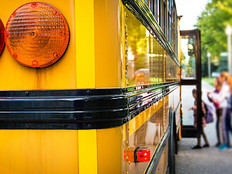Take The Leap
Learn tricks for going wireless from schools that have made the jump to Wi-Fi.
Wi-Fi is transforming the educational experience at Baltimore’s Roland Park Country School, but as its information administrators have discovered, delivering “anytime, anywhere” access is anything but easy.
For seven years, the all-girl, independent K−12 school has required its seventh- to 12th-grade students to bring notebook computers to their classes, and in that time, the IT staff has faced every possible wireless issue. When a pack of students walk down the hallways, they can weaken and even block the wireless signal, which can cause students and teachers in nearby classrooms to momentarily lose their connections. What’s more, as many as 450 students can connect to the network simultaneously. When each period is over, they move to their next classes elsewhere in the school building and reconnect at the same time, a connectivity challenge that requires a well-designed network.
Complicating matters is the fact that students have staggered schedules. They don’t attend the same classes every day, so it’s hard to pinpoint where students congregate every class period. Their schedules also change every semester, making it impossible to architect one perfect network design.
“We are constantly refining the number of access points and where we install them to get the best possible coverage,” says Brian Hoyt, the school’s network administrator.
As the Roland Park project shows, educators face unique challenges when deploying wireless networks.
Uptime is critical. If IT departments are not careful, the excitement created by wireless notebooks can quickly degenerate into a source of frustration for both users and IT staff. To keep a wireless network running at an optimum level, schools must view Wi-Fi as a constant work in progress, say school IT leaders with more than five years’ experience managing wireless networks.
Schools planning their first Wi-Fi installation can take steps to ease the implementation and management process and ensure success. Those steps include proper planning, the flexibility and patience to do troubleshooting anytime, and staying up to date with the latest advances in wireless equipment, IT administrators say.
Conduct a Wi-Fi Reality Check
IT administrators must ensure that their school’s Internet connections are fast enough and their local area networks are robust and stable enough to support Wi-Fi, says analyst Craig Mathias of Farpoint Group in Ashland, Mass.
For example, before installing its first Wi-Fi network in 1998, Roland Park installed Ethernet ports in each classroom and on ceilings to make it easy to install access points, says Phyllis Tripp, the school’s director of technology. The school also subscribes to one T1 line, which meets the campus’ bandwidth needs.
Wi-Fi, however, means low bandwidth, so IT departments must educate faculty to be realistic with the applications they can use, says Lloyd Brown, director of technology for Henrico County Public Schools in Virginia.
Vendors tout 54 megabit-per-second speeds on 802.11a/g access points and 11-Mbps speeds on 802.11b, but actual throughput rates are about half that. That means 30 students on an 802.11g network will have less than 1 Mbps each.
While Web surfing and having teachers show a streaming video on their notebook computers is fine, having everyone do graphics-intensive applications simultaneously is not, Brown says. “If all your users selected a video, you would see the access point saturated.”
Henrico County, which has a one-to-one computing program and recently spent about $1 million on 3,200 new 802.11g access points for its 66 schools, provides students and teachers with nearly two dozen low- bandwidth Web applications for classroom use, including an educational search engine and online tutorials, study guides, games and quizzes for science, social studies and other subjects.
Keep Up With Wi-Fi Advances
Roland Park Country School, which previously standardized on 802.11b, spent $50,000 last year to upgrade to new 802.11a/b/g access points, featuring faster bandwidth, improved security and a new wireless architecture that allows for central network management.

"Schools must set appropriate Wi-Fi security policies."
Photo Credit: ROGER WYAN
In the previous architecture, each “thick” access point carried the intelligence. Network administrators wanting to install a new security policy had to manually install the policy in every access point. With the new architecture, a wireless switch, called a controller, manages and operates all the “thin” access points. Administrators just make the change in the controller and the policy is automatically pushed to every access point.
Clovis Unified School District in California knows firsthand the problems of an older architecture. The district, which first implemented a notebook program in 1996, currently has several five- to seven-year-old 802.11b wireless access points, with a few 802.11g mixed in.
The district’s IT staff must manage the 300 access points individually at 40 schools. Deploying access points from two different vendors has made management even harder because of compatibility problems, says Richard Kebo, director of technology services. For security, the district tried to authenticate users through a remote authentication dial-in user service (RADIUS) directory, but it wouldn’t work because of the two distinct brands of access points, he says.
Another issue is channel crossover. During installation, if access points are too close together, they cancel each other out. Kebo, whose district will upgrade to thin access points next year, has chosen a product that eliminates channel crossover by allowing IT administrators to manage the radio strength of devices.
The new architecture has other perks, including the ability to spot rogue access points and provide immediate notification of hardware failures and better service quality. At Roland Park, for instance, the IT team can give equal bandwidth to every user on an access point by limiting each of the 30 students on an access point to 1/30th of the bandwidth, Hoyt says.
Adjust Access Points During the School Year
It takes trial and error to install access points and ensure that there are no dead spots. Access points typically have a range of 50 to 150 feet indoors, depending on the type and thickness of walls. Hoyt discovered that access points have better signal ranges vertically — up and down each floor — than horizontally between classrooms on the same floor.
Roland Park bought 30 access points for its 50 middle and high school classrooms and installed most of them on classroom ceilings. To ease installation, Tripp recommends a site survey to determine the best sight lines. Tripp and Hoyt began by placing access points where they thought they should be. Then they walked around with a notebook computer to determine signal strength and to locate dead spots.
They installed the network at night. The next morning, students and faculty members gave immediate feedback on areas with poor signal coverage.
It’s important to install the network during the school year and not over the summer when the school is empty, Tripp says. “If you are doing a site survey with no people moving around, it’s almost worthless. You need to do it in a real-world environment, so you can optimize it correctly.”
Tripp and Hoyt spent about two months tweaking the location and number of access points, and they still do that as problems arise, Hoyt says.
Because Roland Park students change classes at the same time, it’s possible but uncommon for roaming students in the hallways to block wireless signals and affect classes, Hoyt says. But this could greatly affect larger schools where students constantly roam the halls, he says. The momentary downtime won’t affect Web- surfing students, but if they’re synchronizing data with school servers, it can stop the synchronization.
Defuse Student Hackers
Not every school secures its Wi-Fi network, but it should. Schools have to worry about student hackers, says Darrell Walery, a member of the Consortium of School Networking’s Emerging Technologies Committee and director of technology at Consolidated High School District 230 in Orland Park, Ill.
“We are one of the few entities where we have hostile users,” he says. “Some students get bored and try to hack into the network and see what they can find.”
The security standards for wireless equipment, such as Wi-Fi Protected Access (WPA) and WPA-2, are good starting points, he says. He recommends separate intrusion detection devices for even greater security. Some schools also use virtual private networks.
At Henrico County Public Schools, Brown gives open access to the network to allow for Web surfing, but requires usernames and passwords for school resources.
“When students open their laptops, they automatically connect to the Internet,” he says. “A lot of people say you need to secure everything, but our goal is to make it a learning tool, so we don’t lock it down completely.”
Tips for buying and installing Wi-Fi equipment
1. To boost bandwidth, consider dual-mode access points that have two radios, one supporting the 802.11b/g standards and another supporting 802.11a, resulting in greater bandwidth. — Craig Mathias, Farpoint Group analyst
2. Vendors say access points can support 64 users, but 30 is a more realistic number. — Brian Hoyt, network administrator at Roland Park Country School
3. Consider tablet PCs. They offer longer battery life and allow teachers to write and draw by hand, as well as walk around while lecturing. Install wireless projectors, so teachers can show their screens without being restricted to a projector’s cable connection. — Phyllis Tripp, director of technology at Roland Park Country School
4. Manage user expectations. Faculty and coaches may want Wi-Fi in open areas, including ball fields, but that’s not safe or practical if homes are nearby and the network is not secure. — Chuck Philips, CIO for the Clovis Unified School District
Wi-Fi in Schools
Percentage of K–12 schools with wireless networks
2001 - 10%
2002 - 15%
2003 - 27%
2004 - 37%
2005 - 45%








